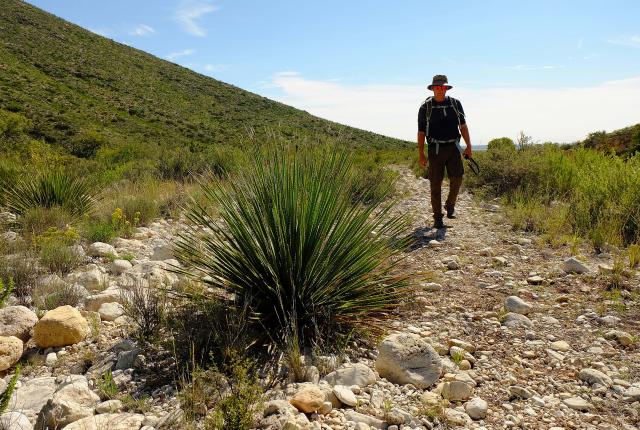MORE THAN 50 MILES OF TRAILS access some 33,000 acres of the park that are designated wilderness areas, where you can take in views of the Guadalupe Mountains rolling on into Texas, explore canyons, and appreciate the park’s standout geology. Although many trails and roads to trailheads were washed out in a storm last August, work is underway to restore access to Juniper Ridge, Rattlesnake Canyon, Slaughter Canyon, Yucca Canyon, and the western side of the Guadalupe Ridge Trail. Check with a ranger for the latest trail conditions.
CHIHUAHUAN DESERT NATURE TRAIL
Search for native plants and signs of wildlife while meandering about a mile toward the escarpment overlooking the Permian Basin. The trail starts east of the visitor center and loops back to the natural entrance, with signs along the way identifying desert icons such as sotol (a type of yucca), catclaw, and agave lechuguilla. “There’s a tremendous variety of plants,” says Rodney Horrocks, chief of natural and cultural resources for Carlsbad Caverns. “It’s interesting when you go hiking in the desert. It seems like everything wants to stick you, prick you, or bite you. That’s why trails are so nice.”
OLD GUANO TRAIL
The 7.5-mile out-and-back trail follows the road used by guano miners in the early 1900s. Guano was harvested from the caverns for use as a fertilizer for citrus groves in California beginning in 1903, until almost all of it had been removed—some 120,000 tons—by 1911. Hikers pass debris from a mining operation, as well as stone culverts and rock quarries headed to White’s City, some 750 feet below.
WALNUT CANYON OVERLOOK TRAIL
The trail begins near the visitor center and requires about five minutes to walk its paved path to where you can peer into the yucca-dotted, broad curves of the namesake canyon.
WALNUT CANYON TRAIL
Off the side of the park road midway through the drive up or down, this very short (less than a half mile) out-and-back walk features a paved path with interpretive signage identifying native plants and explaining their traditional uses by Native Americans—yucca for fiber and soap, ocotillo and algerita berries to eat, Texas walnut wood to make bows—and culminates in a rock shelter used for centuries, the ceiling of which is still stained with woodsmoke.
SLAUGHTER CANYON CAVE TRAIL
Erosion created canyons that reveal cross sections of the Capitán Reef complex, the reef-like formation laid down by an inland sea 265 million years ago. The edges of the sea were surrounded by muddy mounds hosting abundant life—algae, sponges, brachio-pods, ammonoids—that piled up into what made the pale buttresses of the Guadalupe Mountains, sometimes rising 2,000 feet from the desert basin below. Sharp-eyed hikers on the rugged, one-mile out-and-back trail can see fossilized remnants of the life forms that came before them.
Read more: Make the most of your time in and around Carlsbad.



